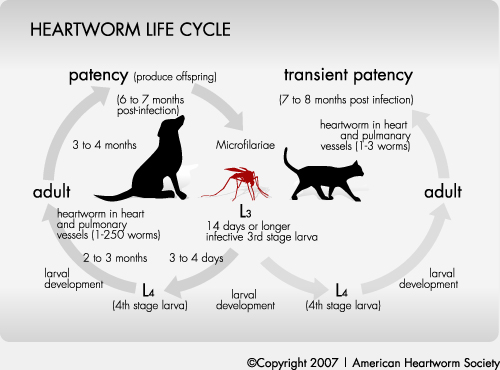Taking again from the Heartworm Society, and trying to put it in a way we can all understand better - and this starts with the dog who is already Heartworm positive and works its way around:
1. Adult female heartworms release their young, called microfilariae, into an animal's bloodstream. So baby worms are the microfilariae.
2. Mosquitoes bite the heartworm positive dog and become infected with microfilariae (baby worms) when they take in that blood.
3. During the next 10 to 14 days, the baby worms mature to the infective larval stage within the mosquito.
4. Then, that infected mosquito bites another dog, cat or other susceptible animal, and the infective larvae enter through the bite wound.
5. It then takes a little over 6 months for the infective larvae to mature into adult worms.
In dogs, the worms may live for up to 7 years. The number of worms infecting a dog can be very high, with the number of worms in dogs ranging from one to approximately 250. We should post another gross picture here. Warning - Gross Heartworm Picture Below!
 |
| Heartworms in the heart of a dog |
 |
| Heartworms in the Pulmonary Artery of a dog |
So:
L1 - Microfillariae aka baby worms
L2 and L3 - Develop in the mosquito over approximately 2-3 weeks time (faster in hotter weather)
L3 - Capable of infecting a new dog, once safely inside the new host, the L3 will spend the next week or two developing into an L4 within the host's skin.
L4 - Will live in the skin for 3 months or so until it develops to the L5 stage and is ready to enter the host's circulatory system.
L5 - Actually a young adult, migrates to the heart and out into the pulmonary arteries (if there is room) where it will mate, approximately 5 to 7 months after first entering the new host.
From: http://www.ampvetclinic.com/Heartworm.php
 |
| Hello, microfilariae |
An important part of a complete heartworm prevention program is testing. All dogs should be tested for heartworm infection before starting a preventive program. Testing ensures that your pet is free of adult heartworms, and ready to start or continue on heartworm preventive medication. The American Heartworm Society (AHS) estimates that only 50% of dogs in areas where heartworm occurs are actually on heartworm preventives. Of those prescribed heartworm prevention products, only about 75% receive all of the doses. Since heartworm continues to be a fatal disease and pet owners' compliance with heartworm prevention is less than optimal, the AHS recommends these guidelines for heartworm testingNext time - those tests and more Mila.

I would like to thank Ultimate Life Clinic for reversing my father's Amyotrophic Lateral Sclerosis (ALS). My father’s ALS condition was fast deteriorating before he started on the ALS Herbal medicine treatment from Ultimate Life Clinic. He was on the treatment for just 6 months and we never thought my father will recover so soon. He has gained some weight in the past months and he is able to walk with no support. You can reach them through there website www.ultimatelifeclinic.com
ReplyDelete